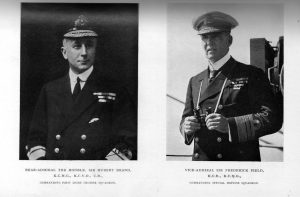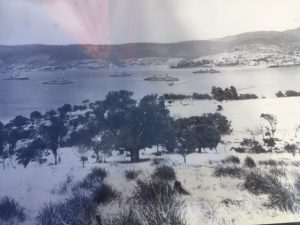- Author
- A.N. Other
- Subjects
- History - Between the wars
- Tags
-
- RAN Ships
- None noted.
- Publication
- June 2019 edition of the Naval Historical Review (all rights reserved)
Rohan Goyne
The ‘World Cruise’ of a special service squadron of the Royal Navy was an inter-war episode of flag waving across the world’s oceans from arguably a declining world power which was struggling to recover from the First World War of 1914-1918. This paper will examine the cruise and in particular how it was received in Australia at the time.
Background
From 27 November 1923 to 28 September 1924, a Special Service Squadron of the Royal Navy composed of the battle cruisers HM Ships Hood and Repulse and the First Light Cruiser Squadron, namely: HMShips Delhi, Danae, Dauntless, Dragon and Dunedin, participated in the ‘Cruise of the Special Service Squadron’. The cruise was also referred to variously as the‘Empire Cruise’,the‘World Cruise’ and the‘World Booze Cruise’.
The squadron was under the overall command ofViceAdmiral SirFrederick L. Field and the Light Cruiser Squadron was under the command of Rear Admiral, the Honourable Sir Hubert G. Brand.
Vital Statistics of the Cruise
The ‘Cruise of the Special Service Squadron’ lasted 307 days in total. The squadron sailed over 38,152 miles and the ships of the squadron were visited by over one million people in the ports at which they stopped during the cruise. As the flagship of the squadron, Hood was visited by approximately 725,490people1.
The Ships of the Squadron
HMS Hood
Hood was built at Clydebank, September 1916 to March1920. She displaced 42,100 tons, ith a complement of 75 officers and 1,165 men for a total of 1,240.
Originally one of an intended class of four battle cruisers designed to match specific German battle cruisers under construction, Hood was the only one of her class completed as intelligence reports confirmed that the German ships would not be completed. She served as the flagship of the Battle Cruiser Squadron of the Atlantic Fleet and prior to the cruise she represented theRoyal Navy at the celebrations of Brazilian independence in 1922 in company withRepulse2.

HMS Repulse
Repulse was built at Clydebank between January 1915 and September 1916. She displaced 32,000tons,with a complement of 55 officers and 1022 men for a total of 1,077.
She was laid down in 1914 as a battleship of the Royal Sovereign class but she was redesigned, cut in half and lengthened by about 170 feet and completed in twenty months as a lightly armoured, shallow draught, fast battlecruiser3.
HM Ships Delhi, Danae, Dauntless, Dragonand Dunedin.
These ships were developments of the Cardiff Class. Their hulls were lengthened by 20 feet to accom modate an additional gun. They each displaced 4,850 tons and had ac omplementof 24 officers and 427 men. The total for the five ships was 2,135men4.
‘The Cruise’
27 November 1923
The squadron left Devonport for SierraLeone. While en route the squadron conducted multiple seaboat, collision quarters and action station exercises. By 3 December the squadron was off the Canary Islands, en route to the West Coast of Africa. The squadron arrived atFreetown, Sierra Leone on 8 December1923.
8-13 December1923
The Squadron remained at Freetown and took on fuel and provisions. Hood was visited by the Governor of Sierra Leone and leave was granted to the Port Watch. The crews conducted gunnery drills and exercised searchlights.The squadron departed for Cape Town on 13 December1923.
13-22 December1923
The ships conducted day and night searchlight exercises en route to South Africa and also action station drills. There was a ‘crossing the line’ ceremony on 14 December 1923 and the squadron maintained an average speed of 14-16 knots down the African coast.
22 December1 923 to 2January 1924
Upon arrival the squadron saluted dignitaries and the flagship Hood was visited by the Acting Governor General. On 24 December the majority of the Hood’s crew participated int he first of many ceremonial marches through Cape Town. Leave was granted to both watches and the squadron received visitors on 23, 24, 26 and 28-31 December. The Squadron Ball was held on26December.
6-12 January 1924
Th squadron was en route to Zanzibar. The ships weret horoughly cleaned and the seaboats’ crews exercised. Small arms parties and searchlight exercises were also conducted.
12-17 January 1924
The squadron arrived at Zanzibar and the ships were opened for visitors. Hood was visited by the Sultan,Khalifa Bin Harud, on 16 January 1924. For the crews life went on as usual with cleaning and provisioning duties. The Royal Marines from Hood also participated in another ceremonial marchpast.
17-31 January 1924
The squadron proceeded to Ceylon (nowSriLanka)and the port of Trincomalee. The squadron was placed in ‘At Home’ status and the ships received visitors but on a smaller scale than elsewhere. The ships were again cleaned, painted and provisioned. The squadron departed for Port Swettenham, Malaya, on31 January 1924.

4-9 February 1924
The squadron arrived at Port Swettenham, Malaya on 4 February. The squadron was placed on ‘At Home’ status and the flagship Hood received the majority of the visitors. Hood also fired ndividual 17 gun salutes for the Sultans of Perak, Pahang and Negri Sembilan. The squadron also experienced its first casualty with the death of Able Seaman Walter Benger who died of malaria. A funeral wasc onducted for him and he was buried in a local cemetery.The squadron departed for Singapore on 9 February 1924.
10-17 February 1924
The squadron arrived at Singapore on 10 February 1924. While in port the ships were provisioned and cleaned. The Royal Marines from Hood participated in another ceremonial march through the city. Hood also saluted his Excellency the Governor of Singapore and other dignitaries with a 17 gun salute. The squadron departed for Western Australia on 17F ebruary and on 20 February 1924 while en route it paid a brief visit to Christmas Island5.
The Special Service Squadron in Australia
The Special Service Squadron arrived in Fremantle, Western Australia, on 27 February 1924. Hood‘s Naval Brigade marched through both Fremantle and Perth.
The squadron also visited the following locations in Australia.
Albany 2-6March
Adelaide 10-15March
Melbourne 17to 25March
Hobart 27March-3April
JervisBay 5-8April
Sydney 9-20April(B.C.)
9-12April(L.C.)
Brisbane 14-22April(L.C.)
Sydney 24-26April(L.C)
Whilst in Melbourne, the squadron suffered its second casualty with the death of Signal Boatswain Albert Punshon who suffered a heart attack. The crew also participated in several sporting and social events6.
The Squadron arrived in Sydney on 9 April 1924. The officers and petty officers of the squadron were well catered for with the provision of dinners and other official functions every night during the squadron’s stay in Sydney.
The ordinary seamen, who numbered many thousands, were given free travel and access to venues such as theatres and sports grounds but were left pretty much to their own devices with few organised functions beyond church services overEaster.
The YMCA provided membership for seamen during their stay with free light meals, recreation and restrooms, Gospel talks, and writing rooms. The large manufacturing firms offered site visits of their factories.
Royal Naval House in Grosvenor Street provided sleeping accommodation for 800 men each night and the Rawson Institute for Seamen was also offering cheap meals, and some entertainment.
The New South Wales Police Force had been acquainted with all the plans to entertain the squadron. Every constable was instructed to gladly afford information and assistance, especially as to travelling instructions.
One particular function performed by the squadron whilst in Sydney was saluting the battle cruiser HMAS Australia as she was taken outside the Sydney Heads for scrapping under the Treaty obligations of the 1922Washington Naval Treaties.
After Australia
The squadron departed Australia for New Zealand on 20 April 1924. It traveled for the next five months across the Pacific stopping in Hawaii and Vancouver before proceeding down the West Coast of the United States and going through the Panama Canal. Hood’s cost tot ransit the Canal was US$22,399.50. The squadron then sailed to Kingston, Jamaica and then to Halifax, Nova Scotia and finally Newfoundland before returning to England on 29 September 1924.

In the House of Commons, NancyAstor, the member for Plymouth, raised questions about why the people of London would not be seeing the men of the squadron performing a ceremonial march through the city on the squadron’s return to England. The Government responded that it was more important for morale if the men were allowed to return to their wives sooner and not be delayed by an unnecessary ceremonial function. The Hansard records for the time do not reveal any statements about the success of the cruise.
The cruise hadt raveled across the globe and some argued it showed that Britannia still ruled the waves. Others have argued that it was an irrelevant piece of flag waving by a dying Empire, an expensive piece of empirical hubris.
Notes:
1 www.hmshood.com/history/empirecruise
2 McMurtrie, F.E., Ships of the Royal Navy, 1940, Sampson Low, Marston & Co., London, p25-27
3McMurtrie, F.E., ibid, 1940, London, p20-23
4 McMurtrie, F.E., ibid, 1940, London, p60-63
5 www.hmshood.com/history/empirecruise
6 www.forcez-survivors.org.uk/empirecruise




